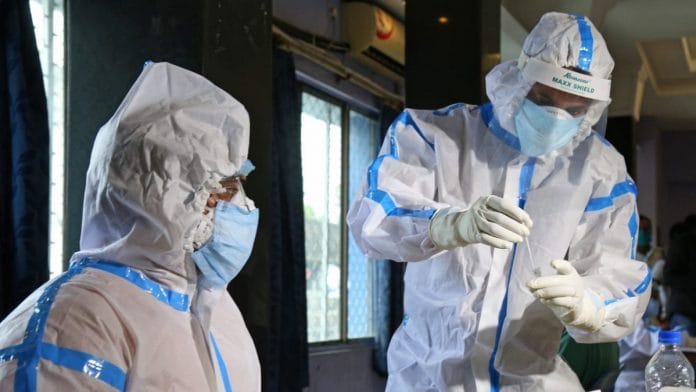Kolkata: West Bengal took as many as five months — from March to July — to cross 70,000 total Covid cases, but doubled that tally in just the past three weeks, with two districts — North 24 Parganas and Howrah — driving the numbers.
On 31 July, the state recorded 70,188 cases and 1,581 deaths. But in the next 24 days, Bengal recorded 1,41,837 cases and 2,851 deaths.
The government has, however, refused to call this a spike and said it’s a “natural progression” of the coronavirus.
Experts, meanwhile, have raised questions on the Covid testing figures, which they said were very low, and also blamed the administration’s inadequate contact-tracing for such a high jump in the Covid cases.
‘State is doing fine’
A senior health department official said this is not a spike as this is how a pandemic progresses.
“It is not a spike, but a natural progression of the virus. It is not specific to Bengal, it is how the pandemic progresses,” he said.
“… in Bengal, the recovery rate has improved to 79 per cent from 68 per cent last month. Our mortality rate has gone down to 1.7 per cent. People are either asymptomatic or reporting mild symptoms. In fact, of the total 28,000 active cases, we have only 1,500 patients, who are critical or reporting serious symptoms. Requirement of hospital beds has also gone down. So, in terms of management of Covid, the state is doing fine,” the official added.
Meanwhile, during a televised administrative meeting at state secretariat Nabanna Monday, Chief Minister Mamata Banerjee said her government would test more and do rigorous contact-tracing.
She also instructed MLAs, councillors and the zilla parishad members to maintain a vigil on the densely populated areas.
Also read: As Covid cases surge, Centre asks West Bengal to step up testing, bring down fatality rate
Questions on testing
Until 31 July, Bengal had tested 8,74,397 samples in total, with 19,000 samples per day.
On 24 August, the government bulletin said the state tested 15,96,578 samples in total at 17,740 tests per million population. Of the total samples tested, 2,57,269 are via antigens tests.
Bengal has 70 Covid testing laboratories approved by the ICMR. Of these, 38 have RT-PCR testing facilities, while the rest conduct tests on TRUENAT or CBNAAT.
Experts have said Bengal should have tested more.
Nimai Bhattacharya, a veteran virologist and former head of School of Tropical Medicine, told ThePrint the state should have by now tested over 1 lakh samples per day.
“Delhi has brought down the numbers after intensifying the tests and tracing. So is there no progression of the virus there? In this way, Bengal will never reach its peak. So many cases were disguised or hidden, and these are infecting others. It is a dangerous situation,” he said.
“And as far as, the recovery rate is concerned, it is not about Bengal, it’s happening everywhere” he added.
Bhattacharya also said inadequate contact-tracing is leading to increasing Covid cases.
Troubled districts
Banerjee, during her administrative meeting Monday, pointed out that North 24 Parganas and Howrah are driving the infection rate in the state.
According to the CM, North 24 Parganas has a worrying infection rate that stands at 20.6 per cent. The district had 30,015 positive cases on 24 August, while it was 15,131 on 31 July.
Howrah recorded 12,456 cases on 24 August and 7,750 on 31 July. Bengal’s average positivity rate is 8.88 per cent as on 24 August.
“No one can explain this spike in North 24 Parganas. It is due to the government’s failure in contact-tracing. I will again come to the testing issue. If they do not ramp up the testing facilities, they will not be able to arrest the infection and will wait to reach the peak for ever,” Bhattacharya said.
North 24 Parganas district is a combination of urban and rural areas. It has two big police commissionerates — Barrackpore and Bidhannagar. The infections are getting traced to the urban areas mostly. The district also shares its border with Bangladesh.
A senior district administration official said, “We have received a huge migrant population. They are mostly residing in urban slums. The international border is now open for truck movement. Moreover, it is one of the densely-populated districts in the state. We are tracing and identifying the cases, and we have also applied for more testing labs.”
Also read: Covid-dengue ‘co-infections’ are Bengal’s new challenge as doctors say treatment very tricky






